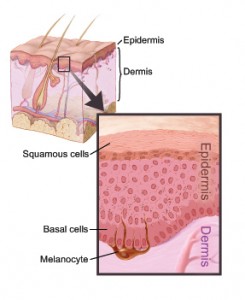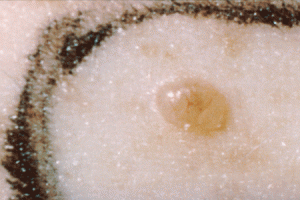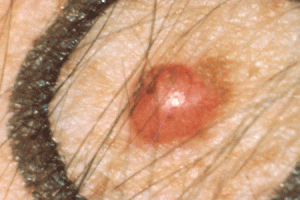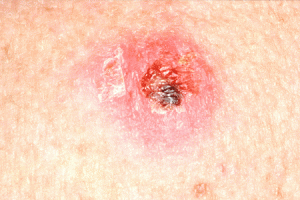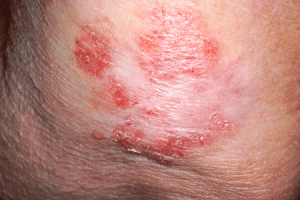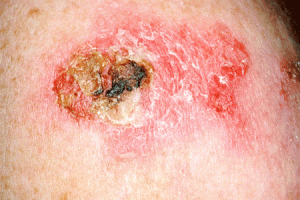- Epidermis: The epidermis is the top layer of the skin. It is mostly made of flat cells. These are squamous cells. Under the squamous cells in the deepest part of the epidermis are round cells called basal cells. Cells called melanocytes make the pigment (color) found in skin and are located in the lower part of the epidermis.
- Dermis: The dermis is under the epidermis. It contains blood vessels, lymph vessels, and glands. Some of these glands make sweat, which helps cool the body. Other glands make sebum. Sebum is an oily substance that helps keep the skin from drying out. Sweat and sebum reach the surface of the skin through tiny openings called pores.
 |
Understanding Skin CancerSkin cancer begins in cells, the building blocks that make up the skin. Normally, skin cells grow and divide to form new cells. Every day skin cells grow old and die, and new cells take their place.
Sometimes, this orderly process goes wrong. New cells form when the skin does not need them, and old or damaged cells do not die when they should. These extra cells can form a mass of tissue called a growth or tumor.
Growths or tumors can be benign or malignant:
- Benign growthsare not cancer:
- Benign growths are rarely life-threatening.
- Generally, benign growths can be removed. They usually do not grow back.
- Cells from benign growths do not invade the tissues around them.
- Cells from benign growths do not spread to other parts of the body.
- Malignant growthsare cancer:
- Malignant growths are generally more serious than benign growths. They may be life-threatening. However, the two most common types of skin cancer cause only about one out of every thousand deaths from cancer.
- Malignant growths often can be removed. But sometimes they grow back.
- Cells from malignant growths can invade and damage nearby tissues and organs.
- Cells from some malignant growths can spread to other parts of the body. The spread of cancer is called metastasis.
Types of Skin Cancer
Skin cancers are named for the type of cells that become cancerous.
The two most common types of skin cancer are basal cell cancer and squamous cell cancer. These cancers usually form on the head, face, neck, hands, and arms. These areas are exposed to the sun. But skin cancer can occur anywhere.
- Basal cell skin cancer grows slowly. It usually occurs on areas of the skin that have been in the sun. It is most common on the face. Basal cell cancer rarely spreads to other parts of the body.
- Squamous cell skin cancer also occurs on parts of the skin that have been in the sun. But it also may be in places that are not in the sun. Squamous cell cancer sometimes spreads to lymph nodes and organs inside the body.
If skin cancer spreads from its original place to another part of the body, the new growth has the same kind of abnormal cells and the same name as the primary growth. It is still called skin cancer.
 Back to Top
Back to Top
 |
Risk FactorsDoctors cannot explain why one person develops skin cancer and another does not. However, we do know that skin cancer is not contagious. You cannot “catch” it from another person.
Research has shown that people with certain risk factors are more likely than others to develop skin cancer. A risk factor is something that may increase the chance of developing a disease.
Studies have found the following risk factors for skin cancer:
- Ultraviolet (UV) radiation:UV radiation comes from the sun, sunlamps, tanning beds, or tanning booths. A person’s risk of skin cancer is related to lifetime exposure to UV radiation. Most skin cancer appears after age 50, but the sun damages the skin from an early age.UV radiation affects everyone. But people who have fair skin that freckles or burns easily are at greater risk. These people often also have red or blond hair and light-colored eyes. But even people who tan can get skin cancer.
People who live in areas that get high levels of UV radiation have a higher risk of skin cancer. In the United States, areas in the south (such as Texas and Florida) get more UV radiation than areas in the north (such as Minnesota). Also, people who live in the mountains get high levels of UV radiation.
UV radiation is present even in cold weather or on a cloudy day.
- Scars or burns on the skin
- Infection with certain human papillomaviruses
- Exposure to arsenic at work
- Chronic skin inflammation or skin ulcers
- Diseases that make the skin sensitive to the sun, such as xeroderma pigmentosum, albinism, and basal cell nevus syndrome
- Radiation therapy
- Medical conditions or drugs that suppress the immune system
- Personal history of one or more skin cancers
- Family history of skin cancer
- Actinic keratosis: Actinic keratosis is a type of flat, scaly growth on the skin. It is most often found on areas exposed to the sun, especially the face and the backs of the hands. The growths may appear as rough red or brown patches on the skin. They may also appear as cracking or peeling of the lower lip that does not heal. Without treatment, a small number of these scaly growths may turn into squamous cell cancer.
- Bowen’s disease: Bowen’s disease is a type of scaly or thickened patch on the skin. It may turn into squamous cell skin cancer.
If you think you may be at risk for skin cancer, you should discuss this concern with your doctor. Your doctor may be able to suggest ways to reduce your risk and can plan a schedule for checkups.
 |
PreventionThe best way to prevent skin cancer is to protect yourself from the sun. Also, protect children from an early age. Doctors suggest that people of all ages limit their time in the sun and avoid other sources of UV radiation:
- It is best to stay out of the midday sun (from mid-morning to late afternoon) whenever you can. You also should protect yourself from UV radiation reflected by sand, water, snow, and ice. UV radiation can go through light clothing, windshields, windows, and clouds.
- Wear long sleeves and long pants of tightly woven fabrics, a hat with a wide brim, and sunglasses that absorb UV.
- Use sunscreen lotions. Sunscreen may help prevent skin cancer, especially broad-spectrum sunscreen (to filter UVB and UVA rays) with a sun protection factor (SPF) of at least 15. But you still need to avoid the sun and wear clothing to protect your skin.
- Stay away from sunlamps and tanning booths.
 |
SymptomsMost basal cell and squamous cell skin cancers can be cured if found and treated early.
A change on the skin is the most common sign of skin cancer. This may be a new growth, a sore that doesn’t heal, or a change in an old growth. Not all skin cancers look the same. Skin changes to watch for:
Sometimes skin cancer is painful, but usually it is not.
Checking your skin for new growths or other changes is a good idea. A guide for checking your skin is below. Keep in mind that changes are not a sure sign of skin cancer. Still, you should report any changes to your health care provider right away. You may need to see a dermatologist, a doctor who has special training in the diagnosis and treatment of skin problems.
 |
DiagnosisIf you have a change on the skin, the doctor must find out whether it is due to cancer or to some other cause. Your doctor removes all or part of the area that does not look normal. The sample goes to a lab. A pathologist checks the sample under a microscope. This is a biopsy. A biopsy is the only sure way to diagnose skin cancer.
You may have the biopsy in a doctor’s office or as an outpatient in a clinic or hospital. Where it is done depends on the size and place of the abnormal area on your skin. You probably will have local anesthesia.
There are four common types of skin biopsies:
- Punch biopsy: The doctor uses a sharp, hollow tool to remove a circle of tissue from the abnormal area.
- Incisional biopsy: The doctor uses a scalpel to remove part of the growth.
- Excisional biopsy: The doctor uses a scalpel to remove the entire growth and some tissue around it.
- Shave biopsy: The doctor uses a thin, sharp blade to shave off the abnormal growth.
You may want to ask your doctor these questions before having a biopsy:
|
 |
StagingIf the biopsy shows that you have cancer, your doctor needs to know the extent (stage) of the disease. In very few cases, the doctor may check your lymph nodes to stage the cancer.
The stage is based on:
- The size of the growth
- How deeply it has grown beneath the top layer of skin
- Whether it has spread to nearby lymph nodes or to other parts of the body
These are the stages of skin cancer:
- Stage 0: The cancer involves only the top layer of skin. It is carcinoma in situ.
- Stage I: The growth is 2 centimeters wide (three-quarters of an inch) or smaller.
- Stage II: The growth is larger than 2 centimeters wide (three-quarters of an inch).
- Stage III: The cancer has spread below the skin to cartilage, muscle, bone, or to nearby lymph nodes. It has not spread to other places in the body.
- Stage IV: The cancer has spread to other places in the body.
 |
TreatmentSometimes all of the cancer is removed during the biopsy. In such cases, no more treatment is needed. If you do need more treatment, your doctor will describe your options.
Treatment for skin cancer depends on the type and stage of the disease, the size and place of the growth, and your general health and medical history. In most cases, the aim of treatment is to remove or destroy the cancer completely.
It often helps to make a list of questions before an appointment. To help remember what the doctor says, you may take notes or ask whether you may use a tape recorder. You may also want to have a family member or friend with you when you talk to the doctor — to take part in the discussion, to take notes, or just to listen.
Your doctor may refer you to a specialist, or you may ask for a referral. Specialists who treat skin cancer include dermatologists, surgeons, and radiation oncologists.
Before you have treatment, you might want a second opinion about the diagnosis and treatment plan. Many insurance companies cover a second opinion if you or your doctor requests it. It may take some time and effort to gather medical records and arrange to see another doctor. Usually it is not a problem to take several weeks to get a second opinion. In most cases, the delay will not make treatment less effective. To make sure, you should discuss this delay with your doctor. Sometimes people with skin cancer need treatment right away.
There are a number of ways to find a doctor for a second opinion:
- Your doctor may refer you to one or more specialists. At cancer centers, several specialists often work together as a team.
- NCI’s Cancer Information Service, at 1-800-4-CANCER, can tell you about nearby treatment centers. Information Specialists also can provide online assistance through LiveHelp at http://www.cancer.gov/cis.
- A local or state medical society, a nearby hospital, or a medical school can usually provide the names of specialists.
- NCI provides a helpful fact sheet called “How To Find a Doctor or Treatment Facility If You Have Cancer.”
You may want to ask the doctor these questions before treatment begins:
|
Your doctor can describe your treatment choices and what to expect. You and your doctor can work together to develop a treatment plan that meets your needs.
Surgery is the usual treatment for people with skin cancer. In some cases, the doctor may suggest topical chemotherapy, photodynamic therapy, or radiation therapy.
Because skin cancer treatment may damage healthy cells and tissues, unwanted side effects sometimes occur. Side effects depend mainly on the type and extent of the treatment. Side effects may not be the same for each person.
Before treatment starts, your doctor will tell you about possible side effects and suggest ways to help you manage them.
Many skin cancers can be removed quickly and easily. Even so, you may need supportive care to control pain and other symptoms, to relieve the side effects of treatment, and to ease emotional concerns. Information about such care is available on NCI’s Web site at http://www.cancer.gov/cancertopics/coping, and from Information Specialists at 1-800-4-CANCER or LiveHelp.
You may want to talk to your doctor about taking part in a clinical trial, a research study of new ways to treat cancer or prevent it from coming back. The section on “The Promise of Cancer Research” has more information about clinical trials.
Surgery to treat skin cancer may be done in one of several ways. The method your doctor uses depends on the size and place of the growth and other factors.
Your doctor can further describe these types of surgery:
- Excisional skin surgery is a common treatment to remove skin cancer. After numbing the area, the surgeon removes the growth with a scalpel. The surgeon also removes a border of skin around the growth. This skin is the margin. The margin is examined under a microscope to be certain that all the cancer cells have been removed. The size of the margin depends on the size of the growth.
- Mohs surgery (also called Mohs micrographic surgery) is often used for skin cancer. The area of the growth is numbed. A specially trained surgeon shaves away thin layers of the growth. Each layer is immediately examined under a microscope. The surgeon continues to shave away tissue until no cancer cells can be seen under the microscope. In this way, the surgeon can remove all the cancer and only a small bit of healthy tissue.
- Electrodesiccation and curettage is often used to remove small basal cell skin cancers. The doctor numbs the area to be treated. The cancer is removed with a sharp tool shaped like a spoon. This tool is a curette. An electric current is sent into the treated area to control bleeding and kill any cancer cells that may be left. Electrodesiccation and curettage is usually a fast and simple procedure.
- Cryosurgery is often used for people who are not able to have other types of surgery. It uses extreme cold to treat early stage or very thin skin cancer. Liquid nitrogen creates the cold. The doctor applies liquid nitrogen directly to the skin growth. This treatment may cause swelling. It also may damage nerves, which can cause a loss of feeling in the damaged area. The NCI fact sheet “Cryosurgery in Cancer Treatment: Questions and Answers” has more information.
- Laser surgery uses a narrow beam of light to remove or destroy cancer cells. It is most often used for growths that are on the outer layer of skin only. The NCI fact sheet “Lasers in Cancer Treatment: Questions and Answers” has more information.
- Grafts are sometimes needed to close an opening in the skin left by surgery. The surgeon first numbs and then removes a patch of healthy skin from another part of the body, such as the upper thigh. The patch is then used to cover the area where skin cancer was removed. If you have a skin graft, you may have to take special care of the area until it heals.
The time it takes to heal after surgery is different for each person. You may be uncomfortable for the first few days. However, medicine can usually control the pain. Before surgery, you should discuss the plan for pain relief with your doctor or nurse. After surgery, your doctor can adjust the plan if you need more pain relief.
Surgery nearly always leaves some type of scar. The size and color of the scar depend on the size of the cancer, the type of surgery, and how your skin heals.
For any type of surgery, including skin grafts or reconstructive surgery, it is important to follow your doctor’s advice on bathing, shaving, exercise, or other activities.
You may want to ask your doctor these questions about surgery:
|
Chemotherapy uses anticancer drugs to kill skin cancer cells. When a drug is put directly on the skin, the treatment is topical chemotherapy. It is most often used when the skin cancer is too large for surgery. It is also used when the doctor keeps finding new cancers.
Most often, the drug comes in a cream or lotion. It is usually applied to the skin one or two times a day for several weeks. A drug called fluorouracil (5-FU) is used to treat basal cell and squamous cell cancers that are in the top layer of the skin only. A drug called imiquimod also is used to treat basal cell cancer only in the top layer of skin.
These drugs may cause your skin to turn red or swell. It also may itch, hurt, ooze, or develop a rash. It may be sore or sensitive to the sun. These skin changes usually go away after treatment is over. Topical chemotherapy usually does not leave a scar. If healthy skin becomes too red or raw when the skin cancer is treated, your doctor may stop treatment.
You may want to ask your doctor these questions about topical chemotherapy:
|
Photodynamic therapy (PDT) uses a chemical along with a special light source, such as a laser light, to kill cancer cells. The chemical is a photosensitizing agent. A cream is applied to the skin or the chemical is injected. It stays in cancer cells longer than in normal cells. Several hours or days later, the special light is focused on the growth. The chemical becomes active and destroys nearby cancer cells.
PDT is used to treat cancer on or very near the surface of the skin.
The side effects of PDT are usually not serious. PDT may cause burning or stinging pain. It also may cause burns, swelling, or redness. It may scar healthy tissue near the growth. If you have PDT, you will need to avoid direct sunlight and bright indoor light for at least 6 weeks after treatment.
The NCI fact sheet “Photodynamic Therapy for Cancer: Questions and Answers” has more information.
You may want to ask your doctor these questions about PDT:
|
Radiation therapy (also called radiotherapy) uses high-energy rays to kill cancer cells. The rays come from a large machine outside the body. They affect cells only in the treated area. This treatment is given at a hospital or clinic in one dose or many doses over several weeks.
Radiation is not a common treatment for skin cancer. But it may be used for skin cancer in areas where surgery could be difficult or leave a bad scar. You may have this treatment if you have a growth on your eyelid, ear, or nose. It also may be used if the cancer comes back after surgery to remove it.
Side effects depend mainly on the dose of radiation and the part of your body that is treated. During treatment your skin in the treated area may become red, dry, and tender. Your doctor can suggest ways to relieve the side effects of radiation therapy. Also, the NCI booklet Radiation Therapy and You offers more information.
You may want to ask your doctor these questions about radiation therapy:
|
 |
Follow-up CareFollow-up care after treatment for skin cancer is important. Your doctor will monitor your recovery and check for new skin cancer. New skin cancers are more common than having a treated skin cancer spread. Regular checkups help ensure that any changes in your health are noted and treated if needed. Between scheduled visits, you should check your skin regularly. You will find a guide for checking your skin below. You should contact the doctor if you notice anything unusual. It also is important to follow your doctor’s advice about how to reduce your risk of developing skin cancer again.
Facing Forward: Life After Cancer Treatment is an NCI booklet for people who have completed their treatment. It answers questions about follow-up care and other concerns. It has tips for making the best use of medical visits. It also suggests ways to talk with the doctor about creating a plan of action for your recovery and future health.
 |
Sources of SupportSkin cancer has a better prognosis, or outcome, than most other types of cancer. Still, learning you have any type of cancer can be upsetting. You may worry about treatments, managing side effects, and medical bills. Doctors, nurses, and other members of the health care team can answer your questions. Meeting with a social worker, counselor, or member of the clergy can be helpful if you want to talk about your feelings or concerns. Often, a social worker can suggest resources for financial aid, transportation, or emotional support.
Support groups also can help. In these groups, patients or their family members meet with other patients or their families to share what they have learned about coping with cancer and the effects of treatment. Groups may offer support in person, over the telephone, or online. You may want to talk with a member of your health care team about finding a support group.
Information Specialists at 1-800-4-CANCER and at LiveHelp (http://www.cancer.gov/cis) can help you locate programs, services, and publications. Also, you may want to see the NCI fact sheet “National Organizations That Offer Cancer-Related Services.”
 |
The Promise of Cancer ResearchDoctors are conducting clinical trials (research studies in which people volunteer to take part).
Clinical trials are designed to answer important questions and to find out whether new approaches are safe and effective. Research already has led to advances, such as photodynamic therapy, and researchers continue to search for better ways to prevent and treat skin cancer.
People who join clinical trials may be among the first to benefit if a new approach is effective. And even if participants do not benefit directly, they still make an important contribution by helping doctors learn more about the disease and how to control it in other patients. Although clinical trials may pose some risks, researchers do all they can to protect their patients.
If you are interested in being part of a clinical trial, talk with your doctor. You may want to read the NCI booklet Taking Part in Cancer Treatment Research Studies. It explains how clinical trials are carried out and explains their possible benefits and risks.
NCI’s Web site includes a section on clinical trials at http://www.cancer.gov/clinicaltrials. It has general information about clinical trials as well as detailed information about specific ongoing studies of skin cancer. Information Specialists at 1-800-4-CANCER or at LiveHelp at http://www.cancer.gov can answer questions and provide information about clinical trials.
 |
How To Do a Skin Self-ExamYour doctor or nurse may suggest that you do a regular skin self-exam to check for skin cancer, including melanoma.
The best time to do this exam is after a shower or bath. You should check your skin in a room with plenty of light. You should use a full-length mirror and a hand-held mirror. It’s best to begin by learning where your birthmarks, moles, and other marks are and their usual look and feel.
Check for anything new:
- New mole (that looks different from your other moles)
- New red or darker color flaky patch that may be a little raised
- New flesh-colored firm bump
- Change in the size, shape, color, or feel of a mole
- Sore that does not heal
Check yourself from head to toe. Don’t forget to check your back, scalp, genital area, and between your buttocks.
- Look at your face, neck, ears, and scalp. You may want to use a comb or a blow dryer to move your hair so that you can see better. You also may want to have a relative or friend check through your hair. It may be hard to check your scalp by yourself.
- Look at the front and back of your body in the mirror. Then, raise your arms and look at your left and right sides.
- Bend your elbows. Look carefully at your fingernails, palms, forearms (including the undersides), and upper arms.
- Examine the back, front, and sides of your legs. Also look around your genital area and between your buttocks.
- Sit and closely examine your feet, including your toenails, your soles, and the spaces between your toes.
By checking your skin regularly, you will learn what is normal for you. It may be helpful to record the dates of your skin exams and to write notes about the way your skin looks. If your doctor has taken photos of your skin, you can compare your skin to the photos to help check for changes. If you find anything unusual, see your doctor.
 |
National Cancer Institute PublicationsNCI provides publications about cancer, including the booklets and fact sheets mentioned in this booklet. Many are available in both English and Spanish.
You may order these publications by telephone, on the Internet, or by mail. You may also read them online and print your own copy.
- By telephone: People in the United States and its territories may order these and other NCI publications by calling the NCI Cancer Information Service at 1-800-4-CANCER (1-800-422-6237).
- On the Internet: Many NCI publications may be viewed, downloaded, and ordered from http://www.cancer.gov/publications on the Internet. People in the United States and its territories may use this Web site to order printed copies. This Web site also explains how people outside the United States can mail or fax their requests for NCI booklets.
- By mail: NCI publications may be ordered by writing to the address below:Publications Ordering Service
National Cancer Institute
P.O. Box 24128
Baltimore, MD 21227
Skin Cancer
Clinical Trials
Finding a Doctor, Support Groups, or Other Organizations
- How To Find a Doctor or Treatment Facility If You Have Cancer (also in Spanish)
- National Organizations That Offer Cancer-Related Services (also in Spanish)
Cancer Treatment and Supportive Care
- Radiation Therapy and You (also in Spanish)
- Understanding Radiation Therapy: What To Know About External Beam Radiation Therapy (also in Spanish)
- Cryosurgery in Cancer Treatment
- Photodynamic Therapy for Cancer
- Lasers in Cancer Treatment
- Eating Hints (also in Spanish)
- Pain Control (also in Spanish)
Coping with Cancer
Life After Cancer Treatment
- Facing Forward: Life After Cancer Treatment (also in Spanish)
- Follow-up Care After Cancer Treatment
- Facing Forward: Ways You Can Make a Difference in Cancer
Advanced or Recurrent Cancer
Risk Factors
- Human Papillomaviruses and Cancer (also in Spanish)
